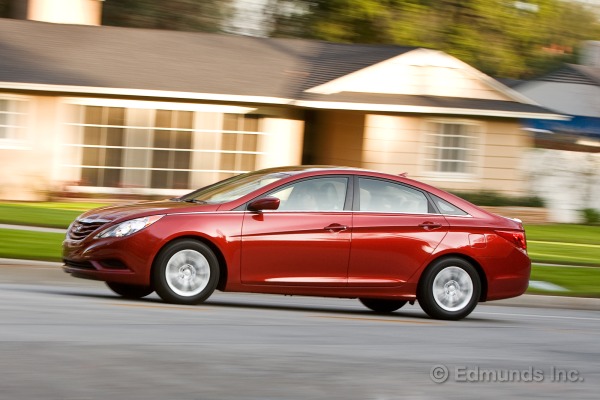
Our long-term 2011 Hyundai Sonata GLS has some cool standard tech features for a base-model car with a sticker price that starts at $20,195: keyless entry with pushbutton start, Bluetooth hands-free and audio streaming, USB port (although you have to buy a $35 cable that also plugs into the adjacent aux-in jack to get iPod integration). Pay an extra $1,700 like we did and you also get a navigation system with a 6.5-inch touch-screen display and XM NavTraffic, NavWeather and Sports and Stocks free for 90 days before having to shell out for a subscription.
And you get a premium Dimension 7-speaker audio system. Don't worry if you never heard of the brand because Hyundai just made it up. But sound-wise it can hold its own -- and then some -- with more familiar audio imprints.
The Setup
The Dimension Premium Audio System in our 2011 Hyundai Sonata GLS consists of seven speakers powered by 360 watts. The speakers include a 6.5-inch midrange in each front door, a 1-inch tweeter in each corner of the dash, another 6.5-inch mid in each rear door and an 8-inch subwoofer in the rear desk. That's it -- a simple but sweet setup.
The Sound
Per usual, I sound-checked the Sonata's system using musical tracks I've listened to in hundreds of cars to determine clarity/lack of distortion, tonal balance, timbre, tonal accuracy, soundstaging, imaging and dynamics. I also used several non-musical test tracks to gauge soundstaging and imaging, linearity and absence of noise. For more details on the testing process and tracks used, check out the Edmunds.com article Sound Advice.
The Sonata's Dimension system is a prime example of how tons of speakers and the logo of a well-known audio brand gracing the components aren't required to get good sound. Admittedly, I use test tracks that highlight flaws in a system, yet I'm also continually surprised that I don't get burned out on the tunes and find myself getting lost in the music with the best systems. That didn't happen in the Sonata, but the system did play the test tracks without any major deficiencies and with a smooth, satisfying response.
Sure, the bass boomed a bit on certain tracks -- and was good if not great with a rap track I use, Outkast's "Ain't No Thang," to test for low-bass extension -- but it was never overly aggressively. And the high end was slightly harsh exactly in parts I expected it would be. But overall the tonal balance was smooth, with little distortion, and the system had a detailed, spacious and very dynamic sound. Timbre and tonal accuracy were largely faithful to the original recordings, although elements of the music, particularly vocals, had a somewhat artificial sound, which I suspect has something to do with the system's signal processing.
My colleague Chris Walton noticed that the system was tuned by noted audio expert Ken C. Pohlmann. (In the interest of full disclosure -- and to brag a bit -- Ken is a regular contributor to Edmunds.com and recently helped with a test of six budget audio systems.) And the Sonata system includes three of Ken's "signature" EQ settings: Normal, Dynamic and Concert. I listened with Normal engaged since I typically try to turn off any processing to compare systems in two-channel stereo. But Pohlmann confirmed that this setting does still use some slight DSP, as do many OEM stereo systems.
The DSP is also what likely helps the Dimension system excel at soundstaging and imaging, which is all the more impressive since the system doesn't have a center-channel speaker. Plus, the dash-mounted tweeters are positioned far forward of the mids in the doors, which usually introduce phasing issues, but didn't seem to negatively affect the sound of the system.
The soundstage was extremely wide, high and exceptionally deep. While imaging wasn't spot on -- center images were just a little to the left from the driver's seat -- it was close enough that it took listening very closely to determine this, which most people aren't going to do while driving anyway.
This was all confirmed by the non-musical staging and imaging tests, and in my listening notes I scribbled "Wow ... and with NO center channel!" Linearity, a measure of how system response holds up at low and mid volume levels, was poor and fair, respectively. And the system passed a zero-bits test for absence of noise, which most usually do.
The Sources
The Sonata GLS has a single-disc in-dash CD player that also includes AM, FM, XM radio. The system has the side-by-side USB port and aux-in jack at the bottom of the center stack that are common in latest-gen Hyundai and Kia vehicles. But you need the aforementioned $35 accessory cable that plugs into both to hook up an iPod.
Once an iPod is connected, control is through the vehicle's touch screen and a menu with the usual playlists, artists, albums, songs and genres categories, as well as composers, audiobooks and podcasts. You get the same functions when you plug in any other USB-compatible music player or a USB drive loaded with MP3 or WMA music files. The system also has Bluetooth audio for wireless music streaming from a smartphone or other compatible device.
What We Say
The Dimension audio system shows that you don't need a recognizable logo on a speaker grille or head unit to get great sound, and that sometimes less is more when it comes to car audio. At $1,700 for the GLS Navigation Package, the price to get the system could be a lot less as well. But the car it comes in at least offers a lot of bang for the buck.
The Scores
Sound: A-
Source Selection: A
iPod Integration: A-
Cost: B-